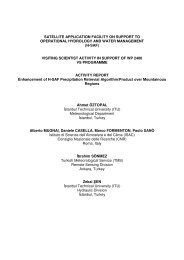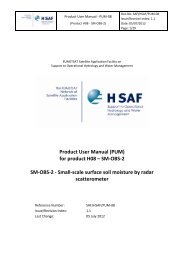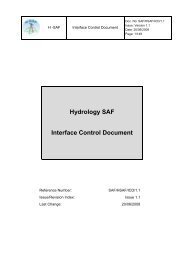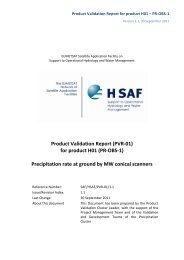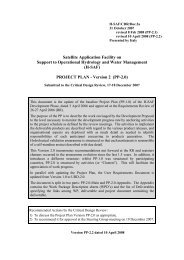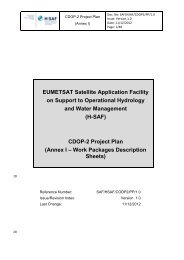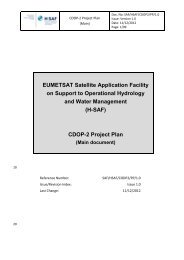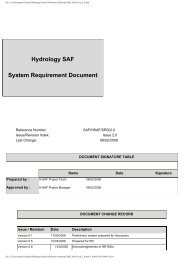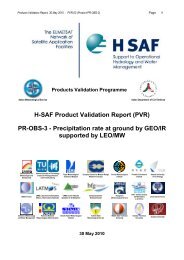Zuhal Akyurek, A. Unal Sorman - H-SAF
Zuhal Akyurek, A. Unal Sorman - H-SAF
Zuhal Akyurek, A. Unal Sorman - H-SAF
Create successful ePaper yourself
Turn your PDF publications into a flip-book with our unique Google optimized e-Paper software.
Chapter 3<br />
Validation Analyses of Blended Snow Cover Product<br />
The validation analyses were done for two study areas within the H<strong>SAF</strong> domain. The first<br />
analysis was performed for the eastern part of Turkey and the second one was performed for<br />
Slovakia.<br />
3.1. Validation for Turkey<br />
Hydrological processes and climate in the mountainous areas are highly affected by the seasonal<br />
snow cover. Essential characteristics both for hydrology and climatology include snow cover,<br />
snow depth (SD) and snow water equivalent (SWE). The maximum SWE prior to the onset of<br />
spring snowmelt is typically the most important snow characteristic for operational runoff and<br />
river discharge forecasts. The concentration of discharge mainly from snowmelt during the<br />
spring and early summer months causes not only extensive flooding, inundating large areas, but<br />
also the loss of much needed water required for irrigation and power generation purposes during<br />
the summer season. Accordingly, modelling snow-covered area in the mountainous regions of<br />
Eastern Turkey, as being one of the major headwaters of the Euphrates–Tigris basin, has<br />
significant importance in forecasting snowmelt discharge, especially for energy production, flood<br />
control, irrigation and reservoir operation optimization. However, the accuracy of SD and SWE<br />
information is currently limited as the level of SD and SWE can only be assessed by<br />
interpolating observations, typically sparse, both spatially and temporally, from gauging<br />
networks and snow courses. The observations are more difficult for mountainous regions<br />
compared to flat areas. Besides knowing the importance of snow as water resources for Turkey,<br />
there is not yet a well established operational snow monitoring system in the country. Therefore<br />
comparison of satellite derived snow maps and snow course ground measurements are vital for<br />
improvement of the existing mapping algorithms.<br />
In this study 30 climate stations and 6 automated weather stations (AWOS) are used in the<br />
validation of ANSA products for eastern part of Turkey (Table 3.1). The validation was<br />
performed for the months November, December, January, February and March for the 2007-08<br />
snow year. In Figure 3.1 the elevation variation in Turkey is given and in Figure 3.2 the locations<br />
of the stations used in the validation study are depicted. The name and the altitudes of the<br />
stations are also given in Table 3.1. The precipitation and the temperature values for climate<br />
stations for the listed months were obtained and the total precipitation values for 10 stations are<br />
given in Figure 3.3.<br />
The ANSA products were obtained for the snow year 2007-2008 and samples of MOD10C1,<br />
AMSR-E and ANSA products are given for January 19, 2008 in Figure 3.4. A systematic<br />
positional shift was observed between ANSA products and the boundary coverage of Turkey,<br />
which was obtained from 500 000 scaled topographic maps. Therefore all the products were<br />
geocoded with the help of the same coverage in order to have an RMS error lower than one<br />
11




